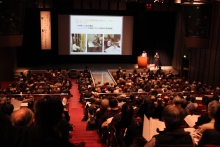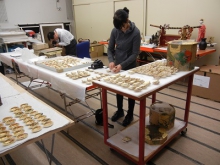Siebold - The Pioneer of Japanism

During the second half of the 19th century, at a time when a boom in Japanism (in French, Japonisme) was sweeping Europe, René Lalique published a number of works with motifs of Japanese garden plants, such as the Lilium longiflorum (White Trumpet Lily). Lalique had never been to Japan. How did he learn about this plants of Japanese origin?
Philipp Franz Balthasar von Siebold, a German doctor who had lived in Japan twice, late in the Edo period (from 1823 to 1829 and then again from 1859 to 1862), brought enormous collections of Japanese arts and crafts, as well as plants, to the Netherlands. We were able to view his collections at the National Museum of Ethnology (Rijksmuseum Volkenkunde) in Leiden, and at the Museum Five Continents (Museum Fünf Kontinente) in Munich, among other places. The plants he had brought back were transported to various parts of Europe and triggered a boom in gardening using plants of Japanese origin. Meanwhile, Japanese art was attracting public attention in Europe, resulting in a boom in Japanism. The plants Siebold brought back from Japan provided artistic stimulation to some artists of the Art Nouveau movement, such as Émile Gallé and René Lalique.
On January 30, 2016, the National Institutes for the Humanities, Japan (NIHU) held a symposium in Tokyo titled
”Siebold’s Introduction of Japanese Culture: Commemorating the 150th Anniversary of His Death.”
The symposium summarized the results of a research project
”Study of the Siebold Family Collection and Other Materials Collected in Japan and Taken Overseas in the Nineteenth Century”
(Hub research center: National Museum of Japanese History, Japan, REKIHAKU) that NIHU has been conducting in the researching and studying Project which is about foreign materials related to Japan.
At the symposium, Josef Kleiner, Professor Emeritus of the University of Bonn and Visiting Researcher of Hosei University Research Center for International Japanese Studies, Hideaki Oba, Professor Emeritus of the University of Tokyo, and Yoko Matsui, Professor of the Historiographical Institute, University of Tokyo, provided a history of the introduction of Japanese culture to Europe and its reception there, and spoke about the plants that Siebold had taken back to Europe and their subsequent influence on Japanism.
This research project will provide an image-attached database with approximately 6,000 items of the Siebold Collection of the Museum Five Continents in Munich on the REKIHAKU website from March, 2016 (Database REKIHAKU)
In addition, it plans to hold a Special Exhibition about Siebold at REKIHAKU from July 12, 2016. In the Botanical Garden of Everyday Life, REKIHAKU, several species of the plants known as Siebold’s Children*, donated by the Leiden University Botanical Garden, have been cultivated, and we can view these plants there.
*Siebold’s Children: Seedlings that people have cultivated from the seeds of Siebold’s plants.

NIHU symposium “Siebold’s Introduction of Japanese Culture: Commemorating the 150th Anniversary of His Death”[January 30, 2016,TOKYO]

Study of Japanese artifacts at the Museum Five Continents in Munich
